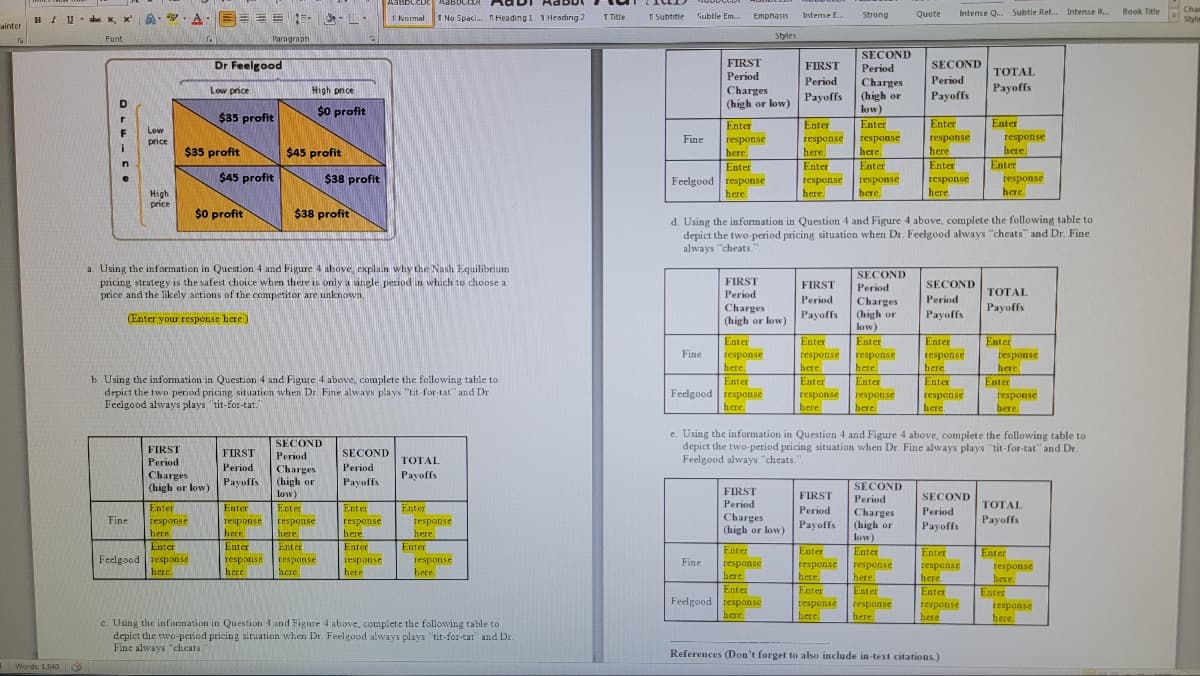a. Using the information in Question 4 and Figure 4 above, explain why the Nash Equilibrium pricing strategy is the safest choice when there is only a single period in which to choose a price and the likely actions of the competitor are unknown.
a. Using the information in Question 4 and Figure 4 above, explain why the Nash Equilibrium pricing strategy is the safest choice when there is only a single period in which to choose a price and the likely actions of the competitor are unknown.
Principles of Economics 2e
2nd Edition
ISBN:9781947172364
Author:Steven A. Greenlaw; David Shapiro
Publisher:Steven A. Greenlaw; David Shapiro
ChapterA: The Use Of Mathematics In Principles Of Economics
Section: Chapter Questions
Problem 3RQ: Exercise A3 What dome slices of a pie chart represent?
Related questions
Question

Transcribed Image Text:ainter
P
BIUX, x AA-
Words: 1,840
Font
DEFICO
r
i
n
Low
price
High
price
Fine
EEEE :
Paragraph
Dr Feelgood
Low price
$35 profit
Enter
response
here
Enter
Feelgood response
here.
$35 profit
FIRST
Period
Charges
(high or low)
$45 profit
$0 profit
FIRST
Period
Payoffs
3-1
High price
Enter
response
here
Enter
response
here.
$0 profit
$45 profit
a. Using the information in Question 4 and Figure 4 above, explain why the Nash Equilibrium
pricing strategy is the safest choice when there is only a single period in which to choose a
price and the likely actions of the competitor are unknown.
(Enter your response here.)
b. Using the information in Question 4 and Figure 4 above, complete the following table to
depict the two-period pricing situation when Dr. Fine always plays "tit-for-tat" and Dr.
Feelgood always plays "tit-for-tat.
$38 profit
$38 profit
SECOND
Period
Charges
(high or
low)
Enter
response
here.
Enter
response
here.
AaBbcсD ME
Normal
SECOND
Period
Payoffs
Enter
response
here.
Enter
response
here.
1 No Spaci... Heading 1 1 Heading 2
TOTAL
Payoffs
Enter
response
here.
Enter
response
here
c. Using the information in Question 4 and Figure 4 above, complete the following table to
depict the two-period pricing situation when Dr. Feelgood always plays "tit-for-tat" and Dr.
Fine always "cheats."
T Title
TSubtitle
Subtle Em....
Fine
Emphasis
Enter
response
here.
Enter
Feelgood response
here.
FIRST
Period
Fine
Charges
(high or low)
Fine
FIRST
Period
Enter
response
here.
Enter
Feelgood response
here.
Styles
Charges
(high or low)
FIRST
Period
Enter
response
here.
Enter
Feelgood response
here.
Intense E...
Charges
(high or low)
FIRST
Period
Payoffs
Enter
response
here.
Enter
response
here.
Strong
d. Using the information in Question 4 and Figure 4 above, complete the following table to
depict the two-period pricing situation when Dr. Feelgood always "cheats" and Dr. Fine
always "cheats.".
FIRST
Period
Payoffs
SECOND
Period
Charges
(high or
low)
Enter
response
here.
Enter
response
here.
SECOND
Period
Charges
(high or
low)
Enter
response
here.
Enter Enter
response response
here. here.
Enter
response
here.
FIRST
Period
Payoffs
Quote
SECOND
Period
Charges
(high or
low)
Enter
Enter
response response
here.
here.
Enter Enter
response response
here.
here.
Intense Q... Subtle Ref... Intense R...
SECOND
Period
Payoffs
Enter
response
here.
Enter
response
here.
SECOND
Period
Payoffs
Enter
response
here.
Enter
response
here.
SECOND
Period
Payoffs
TOTAL
Payoffs
Enter
response
here.
Enter
response
here
References (Don't forget to also include in-text citations.)
Enter
e. Using the information in Question 4 and Figure 4 above, complete the following table to
depict the two-period pricing situation when Dr. Fine always plays "tit-for-tat" and Dr.
Feelgood always "cheats.
response
here
Enter
response
here,
TOTAL
Payoffs
Enter
response
here.
Enter
response
here
TOTAL
Payoffs
Enter
response
here.
Enter
response
here.
Year
Chan
Book Title N
Style
Expert Solution
This question has been solved!
Explore an expertly crafted, step-by-step solution for a thorough understanding of key concepts.
This is a popular solution!
Trending now
This is a popular solution!
Step by step
Solved in 6 steps

Knowledge Booster
Learn more about
Need a deep-dive on the concept behind this application? Look no further. Learn more about this topic, economics and related others by exploring similar questions and additional content below.Recommended textbooks for you

Principles of Economics 2e
Economics
ISBN:
9781947172364
Author:
Steven A. Greenlaw; David Shapiro
Publisher:
OpenStax

Principles of Economics 2e
Economics
ISBN:
9781947172364
Author:
Steven A. Greenlaw; David Shapiro
Publisher:
OpenStax